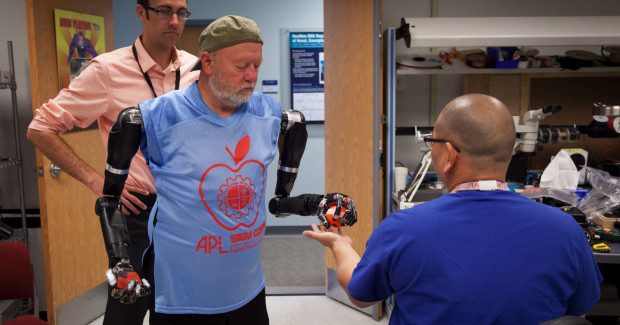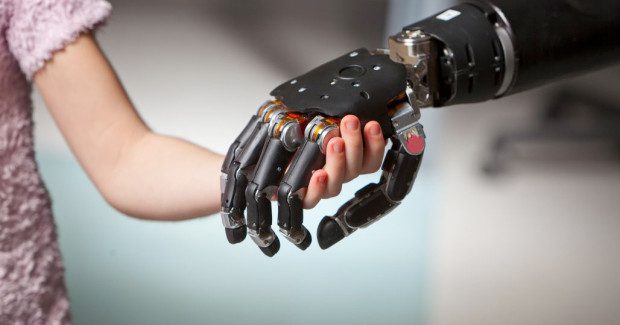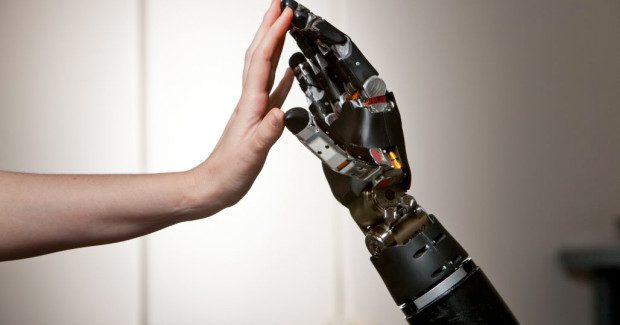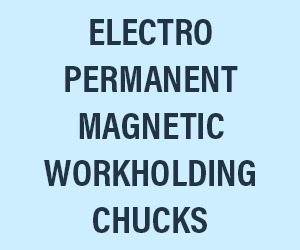Call to Arms
Abrasive waterjet micro machining technology created 23 of the parts used in the fingers, hand, wrist, arm and shoulder of the first Modular Prosthetic Limbs worn and controlled by a bilateral shoulder-level amputee.
Posted: February 3, 2015
A Colorado man made history at the Johns Hopkins University Applied Physics Laboratory (APL) this summer when he became the first bilateral shoulder-level amputee to wear and simultaneously control two of the Laboratory’s Modular Prosthetic Limbs.
A variety of the components used in this device for the fingers, hand, wrist, arm and shoulder were created by Micro Waterjet LLC (Huntersville, NC) for their customer, HDT Global Robotics (Solon, OH), which supplied parts to the Laboratory for this system.
“We have been working with HDT Robotics since 2009 on numerous projects,” explained Steve Parette, the managing director of Micro Waterjet. “During this time, their engineering team became very familiar with the capabilities of our technology.”
Micro Waterjet uses proprietary equipment developed with new Abrasive Waterjet Micro Machining (AWJMM®) technology to cut a wide range of materials, including heat sensitive ones, with a cutting accuracy of ±0.01 mm and a positioning accuracy of ±0.003 mm. This occurs by mixing a very fine abrasive with accelerated water at an average impact speed of approximately 800 m/s to quickly and accurately remove material and produce a finished piece with little to no burr and no heat deformation. For soft materials, such as rubber or silicone, only high pressure water is required.
There are low occurrences of process forces and thermal stress, the water cools the processing spot and transports chips (shavings) away. With these properties even the most delicate contours can be cut, which would bend or melt away using alternative processes. Due to the small diameter of the jet is it possible to create sharp edged contours with high cutting edge quality. With the jet diameter being 0.2 mm, a very high material efficiency is achieved. The start and end points can be chosen almost freely for the machining process.
For this particular project, Micro Waterjet manufactured 23 different parts for this device that are located in the fingers, hand, wrist, arm and shoulder.
Please click here to watch video.
Les Baugh, who lost both arms in an electrical accident 40 years ago, was able to operate the system by simply thinking about moving his limbs, performing a variety of tasks during a short training period.
Baugh was in town for two weeks in June as part of an APL-funded research effort to further assess the usability of the MPL, developed over the past decade as part of the Revolutionizing Prosthetics Program. Before putting the limb system through the paces, Baugh had to undergo a surgery at Johns Hopkins Hospital known as targeted muscle reinnervation.
“It’s a relatively new surgical procedure that reassigns nerves that once controlled the arm and the hand,” explained Johns Hopkins Trauma Surgeon Albert Chi, M.D. “By reassigning existing nerves, we can make it possible for people who have had upper-arm amputations to control their prosthetic devices by merely thinking about the action they want to perform.”
After recovery, Baugh visited the Laboratory for training on the use of the MPLs. First, he worked with researchers on the pattern recognition system. “We use pattern recognition algorithms to identify individual muscles that are contracting, how well they communicate with each other, and their amplitude and frequency,” Chi explained. “We take that information and translate that into actual movements within a prosthetic.”
Then Baugh was fitted for a custom socket for his torso and shoulders that supports the prosthetic limbs and also makes the neurological connections with the reinnervated nerves. While the socket got its finishing touches, the team had him work with the limb system through a Virtual Integration Environment (VIE), a virtual-reality version of the MPL.
The VIE is completely interchangeable with the prosthetic limbs and through APL’s licensing process currently provides 19 groups in the research community with a low-cost means of testing brain–computer interfaces. It’s being used to test novel neural interface methods and study phantom limb pain, and serves as a portable training system.
By the time the socket was finished, Baugh said he was more than ready to get started. When he was fitted with the socket, and the prosthetic limbs were attached, he said “I just went into a whole different world.” He moved several objects, including an empty cup from a counter-shelf height to a higher shelf, a task that required him to coordinate the control of eight separate motions to complete.
“This task simulated activities that may commonly be faced in a day-to-day environment at home,” said APL’s Courtney Moran, a prosthetist working with Baugh. “This was significant because this is not possible with currently available prostheses. He was able to do this with only 10 days of training, which demonstrates the intuitive nature of the control.”
Moran said the research team was floored by what Baugh was able to accomplish. “We expected him to exceed performance compared to what he might achieve with conventional systems, but the speed with which he learned motions and the number of motions he was able to control in such a short period of time was far beyond expectation,” she said. “What really was amazing, and was another major milestone with MPL control, was his ability to control a combination of motions across both arms at the same time. This was a first for simultaneous bimanual control.”
RP Principal Investigator Michael McLoughlin said “I think we are just getting started. It’s like the early days of the Internet. There is just a tremendous amount of potential ahead of us, and we’ve just started down this road. And I think the next five to 10 years are going to bring phenomenal advancement.”
The next step, McLoughlin said, is to send Baugh home with a pair of limb systems so that he can see how they integrate with his everyday life. Baugh is looking forward to that day. “Maybe for once I’ll be able to put change in the pop machine and get pop out of it,” he said. He’s looking forward to doing “simple things that most people don’t think of. And it’s re-available to me.”
“Seeing breakthroughs like this certainly shows what can be achieved with modern manufacturing, and represents true value to those of us who make these individual parts,” added Parette. Micro Waterjet was formed through a joint venture between Waterjet AG and Max Daetwyler Corporation to bring micro manufacturing services for advanced abrasive waterjet technologies to North America.
The company serves a broad range of markets, including aerospace, automotive, electrical/electronic, machine shops, jewelry, medical, motorsports, research labs, and many other specialty applications.
Micro Waterjet LLC, 13420 Reese Boulevard West, Huntersville, NC 28078, 704-948-1223, Fax: 704-875-0781, [email protected], www.microwaterjet.com.


















